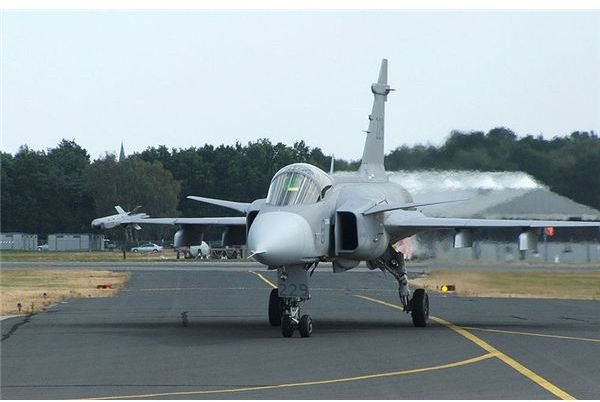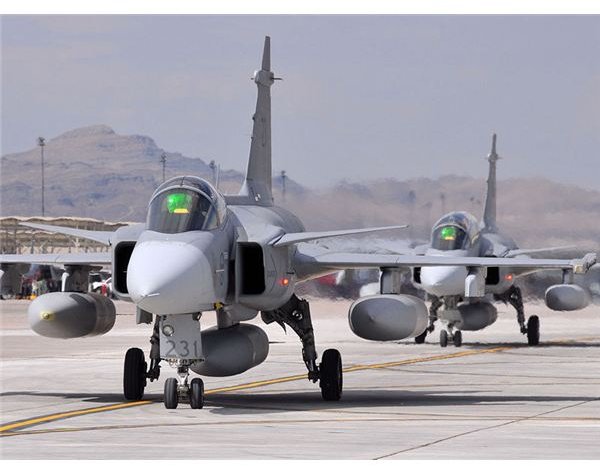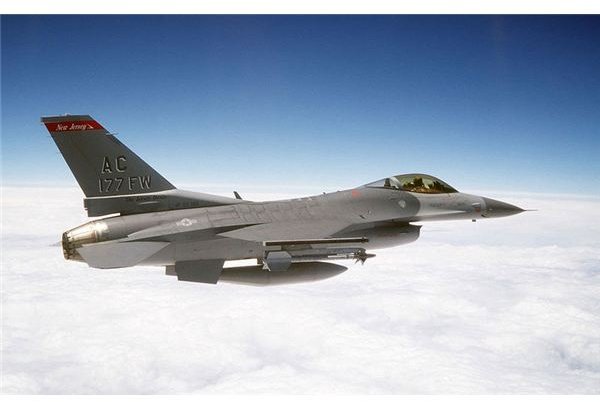Gripen - F-16 Fighting Falcon Comparisons
Gripen - F-16 Comparison: The Griffin and the Viper
The F-16 Fighting Falcon - nicknamed the Viper - has been the standard combat aircraft for many nations since the 70’s. The F-16 has many advantages over contemporary fighters - it is light, maneuverable, and could take on numerous combat roles ranging from reconnaissance to close air support to air superiority.
But the F-16 is beginning to show its age. Significant upgrades have kept the F-16 relevant and dangerous, and a proposed upgraded version has even competed with the Eurofighter in the Indian M-MRCA fighter competition. But a given platform can only be upgraded for so long, and the F-16 is being surpassed by other aircraft - among them the Saab JA3 39 Gripen. F-16 - Gripen comparisons are not entirely fair considering the Gripen is half a generation more advanced than the F-16, but the upgrades made to the F-16 mean that both aircraft compete for the same export markets in many instances.
Gripen vs. F-16 - Light Fighter Structural Matchup
As far as the airframes go, the Gripen - F-16 matchup is close. The Gripen is three feet shorter than the F-16, has a five foot shorter wingspan, and is about a foot shorter. Its overall wing area is slightly smaller, but all in all the Gripen and F-16 are quite similarly sized.

Weight is a point of divergence between the aircraft. The F-16 empty is about 50% heavier than the Gripen - the former weighs about 9 tons empty, and the latter 6. Interestingly enough, the maximum takeoff weight of the Gripen is only a quarter less than that of the F-16 - around 21 tons for the F-16 and about 15 tons for the Gripen. F-16 fighters can handle about 17,000 lbs of external stores compared to the Gripen’s 13,000 lbs - but considering the base empty weight, roughly 40% of the Gripen’s total combat weight is taken up by its airframe, where the F-16 by comparison devoted about 45% of its total weight to its base airframe.
Gripen - F-16 Performance Comparison - Clear Differences
All things equal, the F-16 has a more powerful engine than the Gripen. F-16 fighters mount a Pratt and Whitney afterburning turbofan that produces 50% more thrust than the Volvo jet engine on the Gripen, offering the F-16 a thrust to weight ratio advantage over the Gripen. The Gripen’s thrust to weight ratio is just under 1.00, while the F-16’s is about 1.1, meaning that per unit of weight the F-16 has more energy available to drive the airframe forward. This means the F-16 generally has advantages in acceleration and climb rate.

Of course, the F-16 needs this additional thrust when one of the key factors in fighter maneuverability is considered - wing loading. In general, aircraft with lower wing loading factors can perform tighter turns with less of an energy loss than aircraft with high wing loading. The wing loading factor is in the high 60lb/ft^2 range in the Gripen - F-16 wing loading by comparison is about 88lb/ft^2. What this means is that while the Gripen’s engine is less powerful relative to its size than the F-16, in a pure turning contest it needs less power to restore its airspeed speed after making a turn.
Other performance factors: The two aircraft have similar top speeds at mach 2, the Gripen has a wider combat radius, and the F-16 has a service ceiling roughly 10,000 feet higher than that of the Gripen.
Gripen-F16 Final Word
The performance characteristics of the Gripen mean that, in general, its a lighter, smaller, and more agile fighter than the F-16. Gripens can out-turn Vipers and carry a fighting load further. The radar technology and cockpit electronics are top tier in the Gripen - F-16 tech is naturally less advanced as it is an older aircraft, and meant to complement the F-15 Eagle. The F-16 can accelerate faster and fly higher, meaning it can win in a vertical engagement.
In truth, the fighters are quite similar in capabilities and performance. Possibly the nail in the Viper’s coffin is, unfortunately, its age. The Gripen’s similarities and modernity make it a compelling replacement prospect for aging F-16s.
Gripen - JSF Comparison: Griffin takes on Lightning

The F-35 Lightning II is the result of the Joint Strike Fighter development project initiated by the United States and backed by a range of nations including the United Kingdom and many current users of the F-16. Built by Lockheed, the same company that now owns the F-16 production lines, the JSF project was always intended to replace the aging F-16 much as the F-22 Raptor is now replacing the F-15 Eagle.
Gripen and JSF Matchup - Structural Analysis
Physically, the F-35 is larger than the Gripen. JSF length and wingspan exceeds that of the Gripen fighter by several feet in each dimension, although the JSF is slightly less tall than the Gripen. The Lightning II is over twice as heavy empty as the Gripen - JSF fighters are also more than twice as heavy as Gripens when fully loaded. Of their respective weights, the Gripen is about 40% airframe and 60% fuel and ordnance, while the JSF is about 42% and 58% respectively - actually this indicates the JSF is composed of more composites and other advanced materials than the Gripen as it is physically larger than its competitor.
The F-35 also flies cleaner than the Gripen, JSF aircraft have two built-in internal weapons bays which adds to their stealth and aerodynamic capabilities. These bays can carry around 3000lbs of ordnance in total, and when external hardpoints are utilized the JSF can carry about 9 tons of ordnance.
Gripen - JSF Performance Comparison
The playing field levels significantly when the performance characteristics of the Gripen are considered.

The JSF uses a single Pratt and Whitney afterburning engine, just like the F-16, but can only fly at a speed of about mach 1.6. Its thrust to weight ratio when fully loaded with fuel is only about .87 - significantly less than the Gripen. JSF fighters can achieve a better thrust-weight ratio when carrying half the usual complement of fuel - around 1.07. But if it is viewed as a matter of averages, the thrust to weight factor of the JSF has to be considered to be similar to the Gripen at best - and this with a lower overall speed.
The JSF wing loading factor is in the 90lbs/ft^2 range - significantly less than that of the Gripen and less as well than the F-16 it is meant to replace. In truth, this wing loading factor is higher than that of most fourth generation combat aircraft including the F-15, SU-27, and Mirage 2000. This wing loading factor disparity means the F-35 is significantly less maneuverable in a turning engagement than the Gripen.
JSF fighters have a higher service ceiling but only a slightly better combat radius than the Gripen - and this is on full fuel, which means that the thrust-weight ratio is on the low end during the initial stages of a patrol. With impending upgrades to JAS 39 in the form of the Gripen NG the avionics, radar, and other tech in the aircraft will likely be similar - but of course the JSF has advantages in payload and stealth.
Gripen - JSF Final Word

The JSF can fly higher, carry a heavier payload, and is stealthier than the Gripen. JSF fighters can also fly longer and farther.
The Gripen retains advantages in maneuverability and cost. It is lighter, with a smaller airframe and proven low production and operating costs. The JSF couldn’t hold a candle to the Gripen in a turn, and aside from the max altitude advantage it appears the Gripen would out-climb and out-accelerate the JSF in most circumstances.
In the final analysis, it has to be recognized that the JSF was designed in an era where air-to-air dogfighting has become less of a focus for the United States. The JSF is meant to be a stealthy bomb truck with a legitimate aerial self defense capability. The Gripen is meant to be a rugged, lightweight combat fighter for airspace defense. Different fighters with different purposes will, in the end, be popular with air forces depending on their need.
Gripen International:
https://www.gripen.com/en/GripenFighter/TechnicalSummary.htm
US Air Force:
https://www.af.mil/information/factsheets/factsheet.asp?id=103
Lockheed Martin:
https://www.lockheedmartin.com/products/f35/f-35A-ctol-variant.html
This post is part of the series: The Saab Gripen Fighter: Multiple Variants and Export Oriented
The JAS 39 Gripen by Saab was one of the first generation 4+ combat aircraft, and since its debut it has proven to be a highly cost effective lightweight fighter. In the service of several air forces including its native Sweden, major next generation aircraft competitions feature the Gripen
